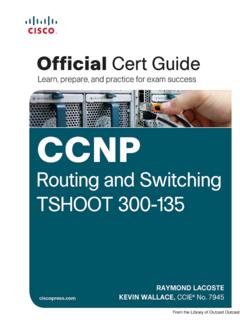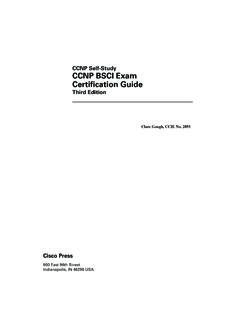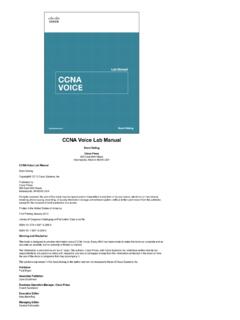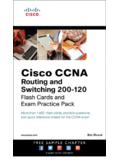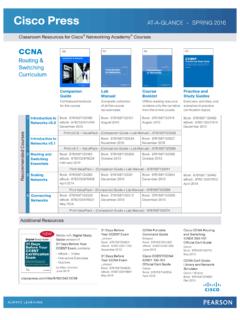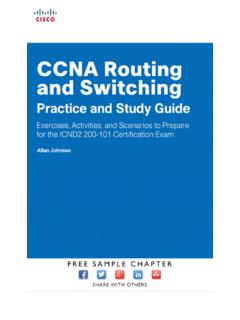Transcription of Cisco CCNA (and CCDA) Study Guide - ipmanager.ir
1 Chapter 1: Understanding Network Models Chapter 1: Understanding Network Models 1 Cisco ccna (and CCDA) Study Guide By Dan DiNicolo, January 25th, 2007 Posted in General. Dan s Free ccna Study Guide is a collection of tutorials designed to help students preparing for Cisco s ccna exam. These tutorials are not a brain dump, a series of cram sheets, or anything of the sort. Quite to the contrary, they are a series of articles designed to help students learn many of the core concepts that they will need to be familiar with both for the exam and in their real-life interactions with Cisco switches and routers. Will reading through every tutorial in this Guide guarantee you a passing score on the ccna exam(s)? Of course not! The tutorials in this Guide are meant to help you learn and understand.
2 If they help you to pass the exam, that s great. You should note, however, that this Guide is not updated to reflect every change that Cisco makes to its exams in terms of topics and depth of knowledge required. Things like that can, do, and almost certainly will change. The links below will help you to navigate through the chapters and individual tutorials that make up this Study Guide . Reader Hint: Because tutorials appear in reverse chronological order in the main body of the chapter index pages, use the All Chapter XX Tutorials list in the right-hand sidebar as your navigation Guide . Additionally, you ll find a link at the bottom of every individual article that will bring you to the next (or previous) article in that particular chapter. When you re all done reading, test your knowledge with our free ccna Practice Exams (SEE FINAL PAGE FOR LINKS).
3 Chapter 1: Understanding Network Models Pages 2 26 Chapter 2: Networking Fundamentals 27 68 Chapter 3: Layer 2 Switching 69 94 Chapter 4: Network Protocols 95 116 Chapter 5: IP Addressing and Subnetting 117 161 Chapter 6: Cisco Router Externals 162 174 Chapter 7: IOS Commands and Configuration 175 216 Chapter 8: Understanding and Configuring Routing 217 267 Chapter 9: Cisco IOS Access Lists 268 293 Chapter 10: Router Troubleshooting 294 308 Chapter 11: Wide Area Network (WAN) Technologies 309 346 Chapter 12: Network Address Translation 347 354 Chapter 1: Understanding Network Models Chapter 1: Understanding Network Models 2 Chapter 1: Understanding Network Models Dan's Free Cisco ccna /CCDA Study Guide Understanding Network Models: Introduction and Modular Design Posted: August 25, 2005 By: Dan DiNicolo The following is part of a complete ccna /CCDA Study Guide by Dan DiNicolo, posted on the web site.
4 Each chapter of the book is presented as a series of articles, and you will find a complete TOC for a given chapter at the bottom of each article once the entire chapter is posted. In the meantime, a complete list of the articles posted in the series can always be found here. A new chapter will be posted as a series of articles each week (approximately), until the entire Study Guide has been posted. The materials in the text are applicable to both Cisco s ccna and CCDA certification exams. In cases where materials apply to one exam only, a note to that effect will be posted within each article. When preparing for your ccna or CCDA, concepts that relate to network models will appear again and again. While these might not seem like the most fascinating topics, I can guarantee a solid understanding of the models and how they relate to network communication and design is critical both on the exams and in real life.
5 Models exist to help illustrate concepts. A fundamental understanding of their goals and responsibilities will ultimately lead to a better appreciation of why networks work the way they do. In this chapter we ll take a look at three different network models, relating them to network communication and design. These include: The Open Systems Interconnect (OSI) Model. Developed by the International Organization for Standardization (ISO), this model is the foundation upon which most network communication protocols are designed. The TCP/IP model. The TCP/IP protocol suite is a culmination of the work of many different companies, individuals, and organizations that took place over many years. While the protocols that make up the suite can be loosely mapped to the OSI model, they are more commonly referenced using the 4-layer TCP/IP model.
6 The Cisco hierarchical network design model. This model is concerned with the design of networks to meet performance, security, capacity and scalability requirements. The key to appreciating the various models is in relating them to real-life networking concepts and scenarios. Be sure to take the time to understand the functions of each model s layers, as well as the protocols and equipment found at each. Chapter 1: Understanding Network Models Chapter 1: Understanding Network Models 3 Modular Design One thing you will quickly notice about network models is that they tend to follow a layered design. I personally prefer looking at them as being modular, because it better conveys the idea of separate and changeable elements. The reason for the distinct sections within various models is simple think of it as a place for everything, and everything in its place.
7 Consider how roles and responsibilities often get separated in real life. At a restaurant, one person may cook your dinner, another serves it, and yet another washes the dishes when you re done. In this way, any one element can be replaced or altered without having a huge impact on the others. Network models work in much the same way, except that each layer has different responsibilities with respect to network communication. The main reasons for following a layered or modular design include: The separation of functions. For example, one layer might be worried about communication reliability, while another is concerned with the technical details of data transmission. Ability to make changes easily. If changes need to be made to a given layer, these can usually be isolated, not requiring a redesign of other layers.
8 Simplification. By dividing roles and responsibilities into different layers, the complexity of networking can be broken down into more manageable sections. This also makes network communication an easier subject to teach and learn. Standardization. If a layered model is an industry standard, vendors can use the model as a blueprint to design systems capable of interoperating. The Open Systems Interconnect (OSI) Model The most popular network communication model by far is the 7-layer Open Systems Interconnect (OSI) model, designed by the ISO in the 1970 s. While today we might take for granted the ability to communicate between different systems, this was not always easy or possible. In the golden days of computing, equipment from IBM couldn t talk to that of Digital, making interoperability difficult to impossible.
9 The goal of the ISO was to create a reference model that would clearly define network functions and responsibilities, ultimately allowing different systems to interconnect and communicate. It is worth noting that the OSI is primarily a reference model, although an actual implementation of an OSI protocol suite does exist. In reality, most network protocol stacks tend to map to the model roughly, but seldom exactly. Chapter 1: Understanding Network Models Chapter 1: Understanding Network Models 4 Figure 1-1: The OSI Model and associated layer numbers. Each of the seven layers is known not only by a name, but also by a number. To that end, you ll often hear the Network layer referred to as Layer 3, or the Transport layer as Layer 4. Remembering the layer names and numbers is critical.
10 Many people get these layers confused in the beginning, so consider using the first letters of each layer to create a mental reminder. Of these, the most popular is probably All People Seem To Need Data Processing . If that doesn t work for you, make up one that will help you remember the order of the layers easily. EXAM TIP: To remember the names and order of the layers in the OSI model, use the first letter of each layer to create a mental reminder (mnemonic), such as All People Seem To Need Data Processing. Network Peers A critical concept to understand when looking at network communication models is the idea of peer layer communication. Peer layer communication is a way of defining how the different layers in the OSI model interact with one another when systems communicate. On a single system, each layer has one or two neighboring layers - the layer above it, and the layer below it.
